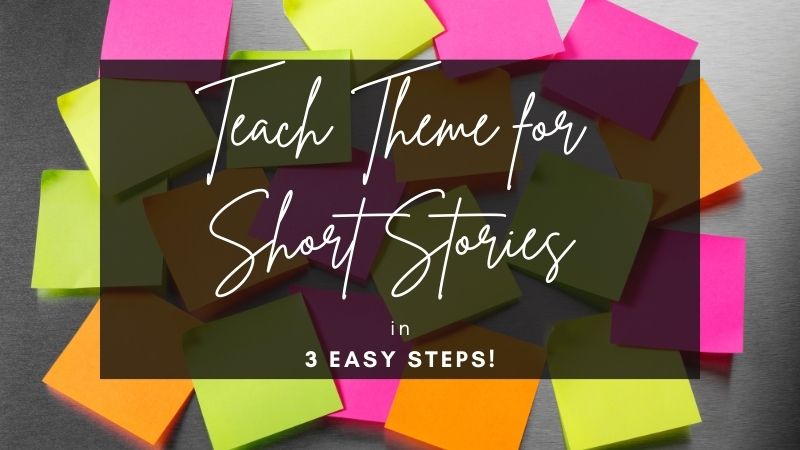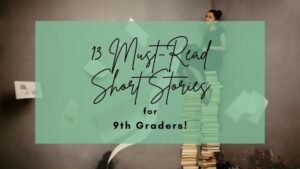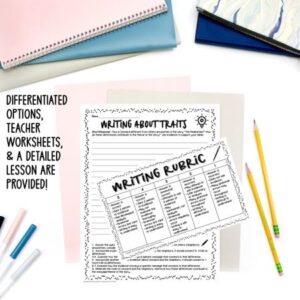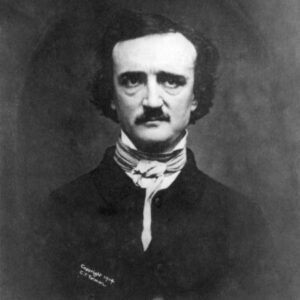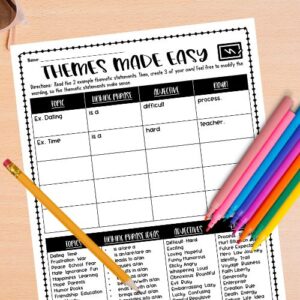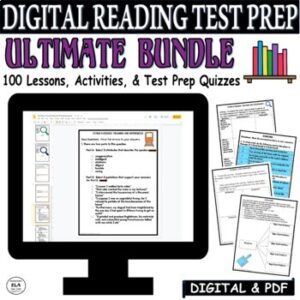Theme seems like an easy concept to understand. I mean, students are exposed to theme through the main or central idea at a very young age in some way, especially when it comes to theme for short stories, poems, or fairy tales. Kids watch and read stories all of the time, and they may comprehend what is going on. However, putting the message of the story into words can be quite challenging.
Many times, there are multiple options for theme for short stories. Plus, the wording of a primary theme can differ greatly and still be correct.
If you need help with teaching theme for short stories, keep reading for lessons, text selections, and activity ideas!!
Need help with Test Prep? Check out this FREE Pack of 3 Test Prep Activities to help students achieve success on standardized tests!
Theme for Short Stories in 3 Easy Steps
Teaching theme for short stories can be taught in several steps, and this process must be taught directly to most students. It is not a natural process to figure out the intended message of the author.
1. Determine the most important textual evidence in the story.
“The Most Dangerous Game” by Richard Connell is rife with relevant ideas that can be developed into the theme for short stories! In fact, it seems that right from the beginning of the story, we are introduced to character language that will shape the theme!
Here is an excerpt from the beginning of the story:
We should have some good hunting up the Amazon. Great sport, hunting.”
“The best sport in the world,” agreed Rainsford.
“For the hunter,” amended Whitney. “Not for the jaguar.”
“Don’t talk rot, Whitney,” said Rainsford. “You’re a big-game hunter, not a philosopher. Who cares how a jaguar feels?”
“Perhaps the jaguar does,” observed Whitney.
“Bah! They’ve no understanding.”
“Even so, I rather think they understand one thing–fear. The fear of pain and the fear of death.”
So, let’s find sentences/phrases that seem important, and then say something about this textual evidence:
- Ex. “You’re a big-game hunter, not a philosopher. Who cares how a jaguar feels?” – Many people care about animals, even hunters. This question about the feeling of a jaguar is incredibly provocative!
- Ex. “The fear of pain and the fear of death.” – Animals and people all experience fear. And fear that pertains to pain and/or death is real for most people.
- Ex. “Bah! They’ve no understanding.” – Rainsford, the primary character, has little pity for animals. We can see that he, as a hunter, will show little compassion to his prey.
Want more ideas for teaching “The Most Dangerous Game?” Check out this post!
While reading for the theme for short stories, any ideas that are repeated throughout should be annotated, written down, discussed, and parsed. Let students marinate on these concepts as they read along. Students are incredibly perceptive, so they will most likely notice things that a teacher may not!
O. Henry’s “The Gift of the Magi” also introduces elements leading to the theme within the first couple of paragraphs.
One dollar and eighty-seven cents. That was all. And sixty cents of it was in pennies. Pennies saved one and two at a time by bulldozing the grocer and the vegetable man and the butcher until one’s cheeks burned with the silent imputation of parsimony that such close dealing implied. Three times Della counted it. One dollar and eighty-seven cents. And the next day would be Christmas.
There was clearly nothing left to do but flop down on the shabby little couch and howl. So Della did it. Which instigates the moral reflection that life is made up of sobs, sniffles, and smiles, with sniffles predominating.
Here are some sentences/phrases that stick out to me:
- Ex. “One dollar and eighty-seven cents. That was all. And sixty cents of it was in pennies.” – Perhaps, the protagonist is poor. She even counts pennies.
- Ex. “Pennies saved one and two at a time” – Della, the first character introduced in the story, clearly worked hard to save one or two cents at a time.
- Ex. “one’s cheeks burned with the silent imputation of parsimony that such close dealing implied” – Della seems a bit ashamed at having to save money by acting cheaply when purchasing goods.
- Ex. “One dollar and eighty-seven cents. And the next day would be Christmas.” Della realizes she has little money and Christmas usually signifies gifts of some sort.
- Ex. “Which instigates the moral reflection that life is made up of sobs, sniffles, and smiles, with sniffles predominating.” This sentence could easily be a theme (message) of the story: Life is mostly sad with some happiness in between.
Now, students may struggle with coming up with the most important events, characters, descriptions, etc., but even if they keep track of what they believe is important, they will usually stumble upon some good information. Not everything is relevant to the theme of short stories, but by the end of most stories, students will see what they need to see in the text.
Simply listening to or reading a story with no mental or physical engagement will not help the average student. I don’t know about you, but I can easily tune out the noise I choose.
And listening to a teacher reading or an audio recording can lead to a lack of engagement.
Instead, have students write down pieces of textual evidence that are significant from beginning to end. And if your students need more focus, give them a list for their notes.
TEXTUAL EVIDENCE
- Events- What are pieces of textual evidence that relate to 5 major events in the story?
- Descriptions- What descriptions of the settings and/or characters look impactful?
- Sentences/Phrases/Words- What language sticks out and is repeated throughout the story?
- Characters- What characters’ words, actions, and thoughts are important from beginning to end?
Most often, students who are struggling readers or students who are trying to read higher-level texts may not be able to develop a thematic statement right after reading a short story, BUT every student can choose and analyze evidence from a short story.
If you need ideas for teaching theme for short stories, check out this list of 13 Must-Read Short Stories for 9th graders!
2. Identify the major topics in a text.
After choosing passages, excerpts, or chunks you want students to read, you can work to help them identify major topics!
For example, if you want to teach “The Pedestrian” by Ray Bradbury, you might come across several important ideas that are vital to understanding the story.
- Social Interaction
- Government Control
- Technological Influence
- Individuality vs. Assimilation
You could help students by reading through this story and finding examples connected to these major ideas. Students may not be able to come up with the big ideas to begin with, especially when reading more complex stories.
So, offering the topics ahead of time might help!
Check out the first paragraph of “The Tell-Tale Heart” by Edgar Allan Poe to determine important concepts in the story, which eventually will lead to the theme for short stories!
True! — nervous — very, very dreadfully nervous I had been and am; but why will you say that I am mad? The disease had sharpened my senses — not destroyed — not dulled them. Above all was the sense of hearing acute. I heard all things in the heaven and in the earth. I heard many things in hell. How, then, am I mad? Hearken! and observe how healthily — how calmly I can tell you the whole story.
- Mental Health- Ex. “The disease had sharpened my senses — not destroyed — not dulled them.”
- Evil vs. Good- Ex. “Above all was the sense of hearing acute. I heard all things in the heaven and in the earth. I heard many things in hell.”
- Storytelling- Ex. “and observe how healthily — how calmly I can tell you the whole story.”
If you start teaching theme for short stories by Edgar Allan Poe, like “The Tell-Tale Heart,” with smaller chunks or paragraphs and model what identifying major topics could look like, it will make the process of coming up with a theme MUCH EASIER by the end of the story. (Want easy-to-teach lessons and activities for Poe’s “The Tell-Tale Heart?” Click HERE!)
3. Explain the Theme Equation.
After students have read the ENTIRE story, determined important textual evidence in connection to meaning, and identified major topics, it is time to work on creating the theme for short stories!
One of the most effective ways to get your students to understand theme for short stories is to expose them to the following equation:
Major Idea + Topic Phrase = Theme
- MAJOR IDEA: Technology
- TOPIC PHRASE: Being consumed by technology
- THEME: Consuming too much technology can lead to a superficial life.
You don’t even need a short story to practice writing a theme for short stories! This activity pack (Themes Made Easy) makes introducing thematic statements SIMPLE & EFFECTIVE!
Top 15 Theme for Short Stories Texts
My favorite short stories to teach theme for short stories include a range of options for middle and high school students:
-
- The Tell-Tale Heart – Edgar Allan Poe’s classic of a character being haunted by his actions through a metaphorical heartbeat will hook students as they focus on theme for short stories. Adding in the analysis of character and imagery is the reason this is a must-teach! Check out the bundle of activities to go with this story!
- Thank you, Ma’am – Langston Hughes’ story is one where the greater good wins out to change the course of a young man’s life. With its two-character focus, this story is ideal for character analysis and comparison. Get your copy of the full lessons here in digital and print.
- The Pedestrian – Ray Bradbury’s dystopian story set in 2131 features a man who walks the city while everyone else watches television. This seems like a simple premise, but when the man encounters the police and declares he’s a writer, the values of society are revealed. With its social commentary that remains poignant in our times, this story is a good one to explore theme. It also provides opportunities for text-to-world connections and discussion. Check out the full lessons done for you!
- The Veldt – Another of Bradbury’s science fiction short stories, this one defies all expectations with a virtual reality simulation gone quite wrong… or right depending on the point of view! To teach this story with an added focus on character and the symbolism of the title and setting, check out this bundle.
- The Gift of the Magi – O. Henry’s heartwarming story focuses on a young couple’s sacrifices to give each other meaningful holiday gifts. This story is a good choice for theme and big ideas as well as close reading and literary analysis with repetition, allusion, and irony. Check out all of the lessons for this story.
- The Necklace – Guy de Maupassant’s story of riches to rags and letting go of one’s pride provides such a marvelous twist at the end that this is a must-teach! For lessons with close reading and textual analysis with a focus on character, setting, and theme grab this bundle that’s all ready for you!
- The Most Dangerous Game – This story by Richard Connell is about a hunter of humans rather than animals. This story will ensure students understand unexpected plotlines with comprehension quizzes, tracking story elements, and writing about the effectiveness of one key aspect. You can find complete lessons with teacher answers here.
- The Scarlet Ibis – James Hurst tells the tragic story of a young boy nicknamed Doodle from the point of view of Doodle’s unnamed brother. This heart-wrenching story with a focus on flashbacks and foreshadowing will encourage students to examine the structure and infer the order of the story. Check out this easy-to-use bundle.
- Lamb to the Slaughter – A horror story with a side of comedy, Roald Dahl’s classic is a great option for close reading and character analysis. Get your copy of the lessons here.
- After Twenty Years – Two friends follow different life paths but plan to meet up in 20 years; however, their meeting goes awry with a delightful twist! This story by O. Henry can help students to break down the plot into chunks so they better understand character and action. Get the bundle of lessons here.
- The Monkey’s Paw – This story is best summarized as be careful what you wish for! The protagonist of W. W. Jacobs’ horror story is granted three wishes, but when he messes with fate, things go very, very wrong. Use this story to focus on summaries, particularly 1-sentence summaries, before diving into characterization. Get started with this lesson bundle.
- To Build a Fire – A classic Jack London man versus nature story in the Yukon Territories’ extremely cold setting. Explore the setting and its strong imagery with this full bundle of activities.
- The Cask of Amontillado – This horror story, also by Poe, told from the point of view of the murderer is a tale of revenge for a wrong seemingly committed long ago. The story is brimming with character details to track and analyze. Grab your copy of the full lessons for this Poe story here.
- The Lottery – Who knew that all traditions were not good? Well, Shirley Jackson most definitely does. Click to view ready-made printables to make teaching this dystopic tale engaging for your students!
- The Masque of the Red Death – This timely tale of disease and death has a wealth of thematic options! Edgar Allan Poe masterfully captures elements of pride and destruction, which your students will be able to easily connect with during the age we are in! See this BUNDLE for lessons, activities, and test prep ideas!
Need more help with teaching theme for short stories? Check out my store Kristin Menke-Integrated ELA Test Prep!
Click here to JOIN my email list for more reading comprehension ideas and to download “13 Effective Ways To Integrate Test Prep Into Your Classroom!”

